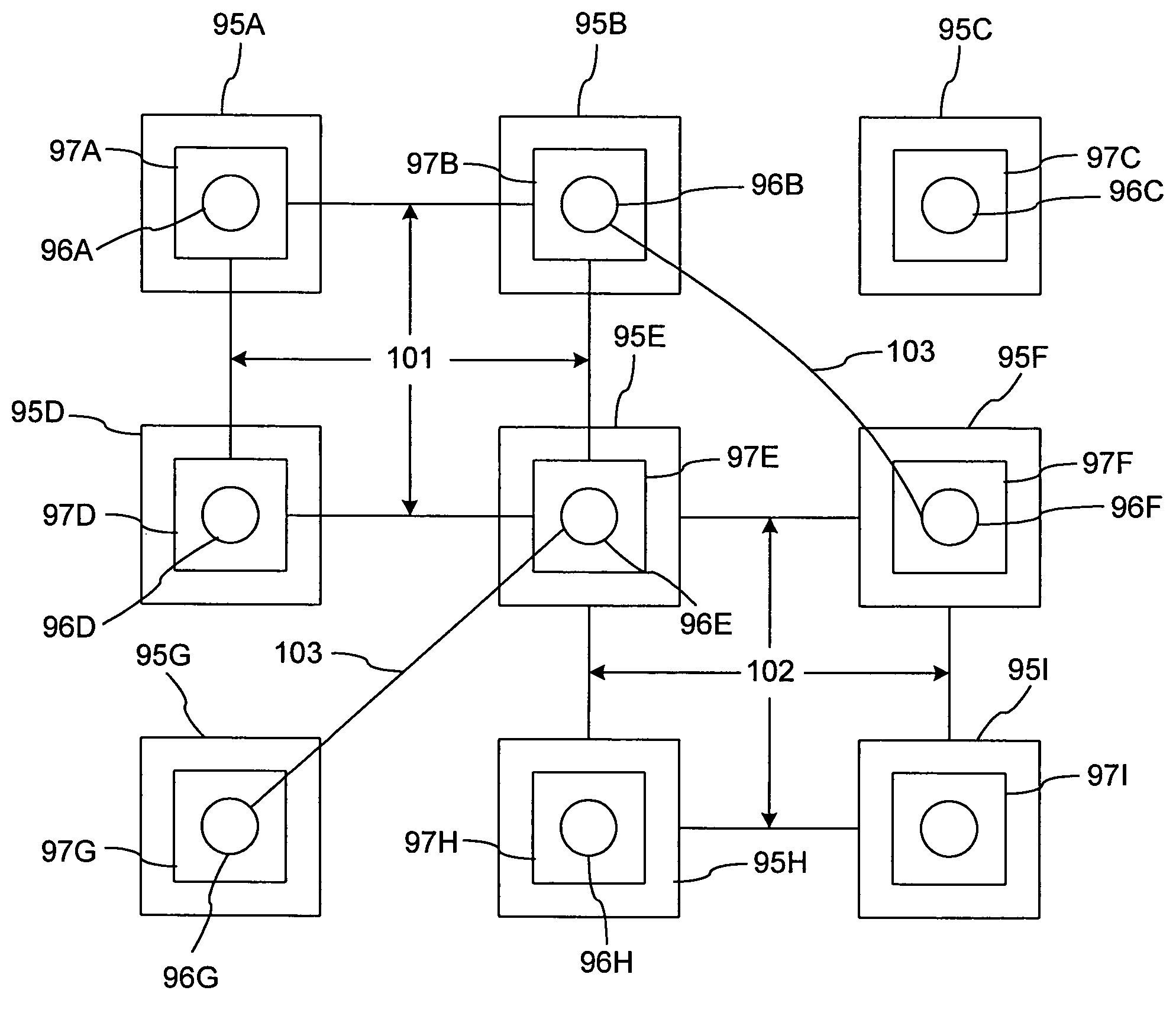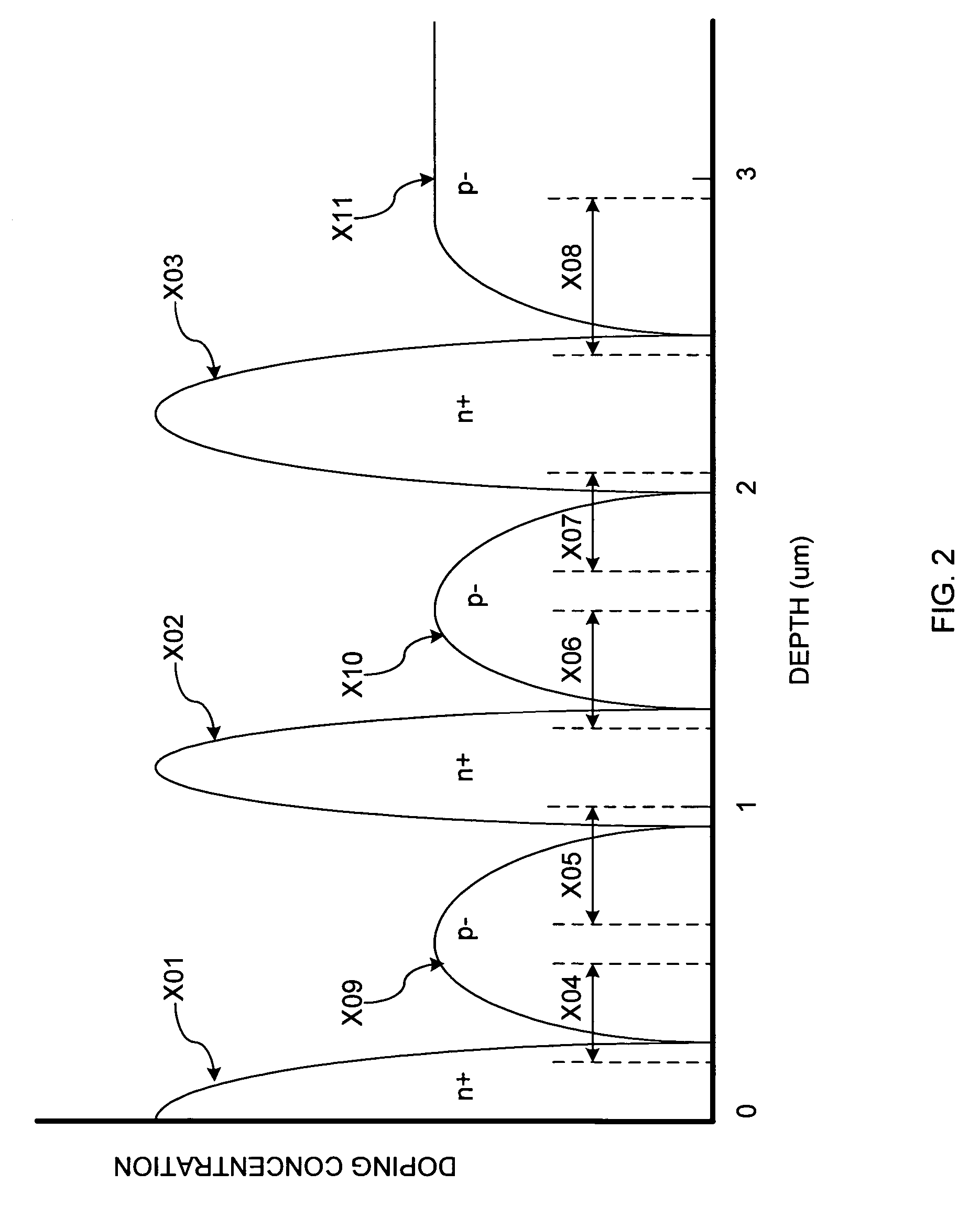[0022]In other embodiments, the sensors of each VCF sensor group of the inventive array have different size, and at least one sensor of each VCF sensor group is shared with another sensor group. The outputs of the sensors of two such sensor groups are “combined” in the sense that the output of a single sensor shared by the sensor groups (the shared sensor having a carrier-collection element shared by the sensor groups) is used. This eliminates the need to connect laterally separated, distinct carrier-collection elements of distinct sensors of adjacent sensor groups to combine the outputs of such sensors. For example, in one embodiment, the blue sensors of each VCF sensor group have small size (this is typically appropriate since blue sensors are typically implemented near the top surface of a
semiconductor wafer), and each set of four adjacent VCF sensor groups can share a larger red sensor (the carrier-collection element of the red sensor, which is implemented deeper in the
wafer, has area roughly equal to four times the area of each blue sensor). In this example, the output of one red sensor (shared by four adjacent sensor groups) emulates the red component of one block of a Bayer pattern, and the outputs of the blue sensors of a different set of four adjacent sensor groups (diagonally offset from the sensor groups that share the red sensor) are combined to emulate the blue component of the same block of the Bayer pattern. In this example, the green sensors can have any of a variety of sizes. For example, the carrier-collection element of each green sensor can be an oblong area shared by two diagonally offset sensor groups, having size about half the size of the red sensor), or the carrier-collection element of each green sensor can have the same size as the carrier-collection element of each blue sensor. In the former case, the output of one green sensor (shared by two adjacent sensor groups) emulates one
green component of the block of the Bayer pattern, and the output of another green sensor (shared by two other sensor groups) emulates the other
green component of the block of the Bayer pattern. In the latter case, the combined output of two green sensors (of two adjacent sensor groups) emulates one
green component of the block of the Bayer pattern, and the combined output of two other green sensors (of two other sensor groups) emulates the other green component of the block of the Bayer pattern.
[0024]In a class of embodiments, the inventive array can be switched between at least two different states (e.g., one implementing a Bayer pattern and another implementing another
color sensor pattern). For example, switching the array between different states can enable increased resolution in interpolated images by capturing two color sub-sampled images and combining them. In addition, the ability to change the state of the array simplifies integration of the array with other components of a
system configured to work with a particular orientation or type of
color filter array pattern. In some such embodiments, the inventive array comprises rows and columns of VCF sensor groups, at least one sensor of each sensor group is combinable with any of at least two different sets of other sensors (e.g., with no other sensors, or with sensors of three adjacent sensor groups), and readout circuitry is configured to accomplish read out with the array in any of its possible states. For example, the readout circuitry can be configured to selectively combine the outputs of individual sensors of individual sensor groups to allow the array to emulate any of at least two different
color sensor patterns.
[0025]In some embodiments, the inventive array of VCF sensor groups uses color sub-sampling in at least one channel, but full sampling in at least one other channel (e.g., the outputs of individual green sensors are not combined, but the outputs of red sensors at another layer of the array are combined and the outputs of blue sensors at a third layer of the array are combined). In some embodiments, any selected one of
two layer signals (each indicative of photons of a different
wavelength band) can be read out from each sensor group of the inventive array. The layer signals can be output on separate column output lines, the column output lines being shared by sensor groups that lie along the same column of the array. Thus, in some such embodiments, photons in any selected one of two wavelength bands can be collected at each pixel location. For example, the red and blue wavelength bands can be sub-sampled by sensing red or blue illumination at alternate VCF sensor group locations within the array, while the green
wavelength band can be sensed at every location within the array. This technique provides
high resolution and reduced
aliasing while still maintaining some of the benefits of reading out only two colors per pixel, the primary benefit being reduced complexity of readout circuits which leads to better yield and increased
fill factor.
[0026]In variations on each disclosed embodiment of the inventive VCF sensor group array, a pattern of optical color filters is applied over the top sensors of the VCF sensor groups of the array (or between sensors at different
layers of some or all of the VCF sensor groups of the array). Using only a single
filter material, an array with three sensors per VCF sensor group can be augmented to detect light with 4, 5, or 6 different
spectral sensitivity ranges, to yield potentially improved color accuracy. For example, the
filter material can be an
organic dye filter as in prior-art
color image sensors, or it can be a layer integrated into the
semiconductor fabrication process, such as either a layer of polysilicon to absorb short wavelengths, or a stack of alternating
oxide and
nitride layers to shape the
spectral response by interference effects. Other interference-based
dielectric filter stacks are also possible in conjunction with the inventive arrays of VCF sensor groups. While use of a single
filter material permits up to six different spectral sensitivities, the present invention is in no way limited to the use of a single filter material, and sensor group arrays that employ VCF sensor groups in combination with color filters that have multiple different
spectral transmission characteristics are possible and may be desirable for certain applications.
 Login to View More
Login to View More  Login to View More
Login to View More 


